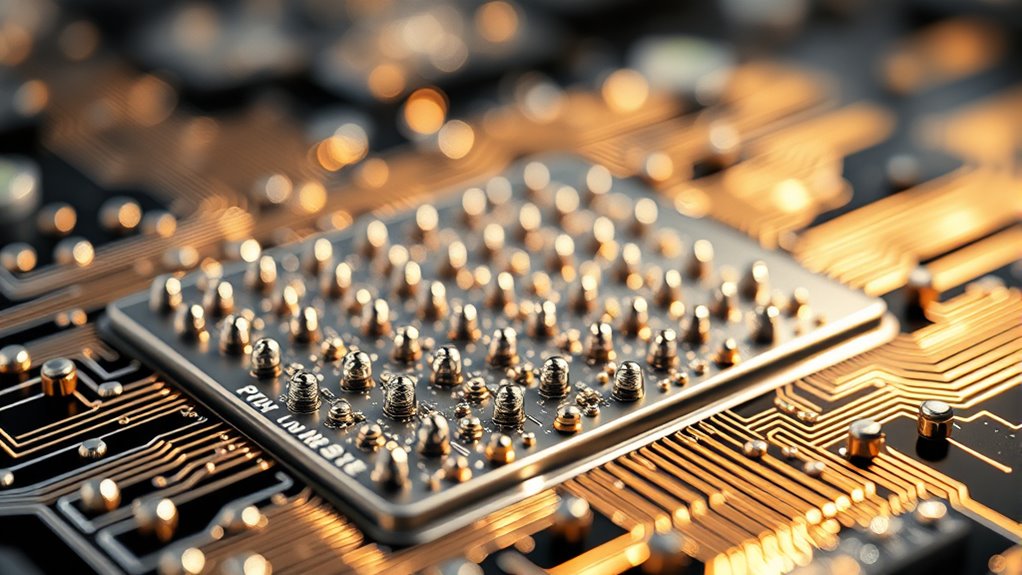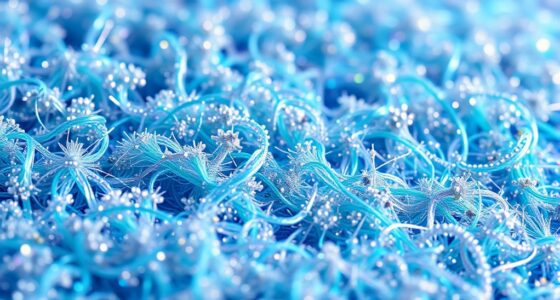Magnetic nanoparticles are used in various devices because they offer unique properties like superparamagnetism and high surface reactivity, making them ideal for advanced electronics, sensors, and medical tools. Their size and customizable magnetic responses allow for precise control in applications such as data storage, targeted drug delivery, and environmental monitoring. You’ll discover how these tiny particles are transforming technology and opening new possibilities as you explore further.
Key Takeaways
- Magnetic nanoparticles are integrated into sensors and memory devices for enhanced data storage and magnetic field detection.
- They enable targeted drug delivery systems and MRI contrast agents in medical devices through precise magnetic control.
- Nanoparticles improve the performance of spintronic devices by manipulating magnetic moments at the nanoscale.
- Surface modifications facilitate their incorporation into electronic components, enhancing device stability and functionality.
- Their tunable magnetic properties allow customization for specific applications in environmental sensors and contaminant removal devices.

Have you ever wondered how tiny magnetic particles revolutionize modern technology? The secret lies in their unique magnetic properties, which allow them to perform functions that bulk materials simply can’t achieve. These properties—such as superparamagnetism, high surface area, and adjustable magnetic moments—are what make magnetic nanoparticles so valuable in a wide range of devices. To harness these capabilities, scientists focus heavily on nanoparticle fabrication, a meticulous process that controls size, shape, and surface characteristics to optimize performance. When you understand the basics of magnetic properties and how they’re manipulated during fabrication, you gain insight into how these tiny particles are transforming electronics, medicine, and data storage.
Magnetic properties at the nanoscale differ considerably from those of larger particles. For instance, nanoparticles can exhibit superparamagnetism, where they become magnetized only in the presence of an external magnetic field and lose their magnetism once the field is removed. This characteristic is essential for applications like magnetic resonance imaging (MRI) contrast agents or targeted drug delivery, where you want precise control over magnetization without residual magnetism. The high surface-to-volume ratio of nanoparticles also enhances their magnetic response, making them more reactive and effective than their bulk counterparts. Their small size allows them to penetrate tissues or integrate seamlessly into electronic systems, broadening their use across multiple industries. Additionally, the magnetic response of nanoparticles can be tuned by adjusting fabrication parameters, leading to customized applications.
Achieving these properties depends on nanoparticle fabrication techniques. Methods like chemical reduction, sol-gel processes, or thermal decomposition enable scientists to produce particles with consistent size and shape. Precise control during fabrication guarantees that the magnetic properties are tailored to specific needs. For example, uniform spherical nanoparticles might be preferred for biomedical applications, while elongated particles could be better suited for data storage devices. During fabrication, surface modifications are often implemented to improve stability, prevent aggregation, or add functional groups that enhance interactions with biological systems or electronic components.
Once fabricated, these magnetic nanoparticles can be integrated into various devices. In electronics, they serve as components in magnetic sensors, memory devices, and spintronic systems, where their magnetic behavior underpins data processing and storage. In medicine, they facilitate targeted therapies, enabling drugs to be directed precisely where needed with magnetic guidance. Their small size and magnetic properties also make them ideal for environmental sensors, removing contaminants from water or air. As research advances, the ability to fine-tune nanoparticle fabrication processes means that these tiny particles will continue to release new possibilities in technology, medicine, and beyond.
Frequently Asked Questions
How Do Magnetic Nanoparticles Affect Device Lifespan?
Magnetic nanoparticles can extend your device’s lifespan if they maintain stability and resist degradation under magnetic field strength. Stable nanoparticles prevent corrosion and reduce wear, ensuring consistent performance over time. If they degrade or agglomerate due to weak stability or excessive magnetic fields, your device may experience reduced efficiency or failure. Properly engineered nanoparticles optimize device durability by balancing stability with magnetic field strength, ultimately enhancing longevity.
Are Magnetic Nanoparticles Environmentally Safe?
Are magnetic nanoparticles environmentally safe? While they offer benefits in various applications, you should consider their environmental impact and regulatory concerns. These nanoparticles can accumulate in ecosystems, potentially harming wildlife or entering the food chain. Regulatory agencies scrutinize their use to minimize risks. So, it is crucial to evaluate their safety thoroughly and develop guidelines to guarantee their responsible use, helping protect our environment and public health.
What Are the Costs of Integrating Magnetic Nanoparticles?
You should consider that the costs of integrating magnetic nanoparticles involve a detailed cost analysis, which includes synthesis, functionalization, and quality control. Manufacturing challenges, such as scaling up production and ensuring consistency, can considerably increase expenses. While initial investments might be high, long-term benefits like improved device performance could justify these costs. Careful planning helps you manage expenses effectively and overcome potential manufacturing hurdles.
Can Magnetic Nanoparticles Be Recycled From Devices?
Yes, magnetic nanoparticles can be recycled from devices, but the process isn’t straightforward. Imagine a device opened, revealing tiny, magnetic particles still embedded within. You’ll need to carefully extract and perform nanoparticle recovery, ensuring they’re not contaminated or damaged. This makes device recycling challenging but not impossible. Advanced techniques allow for the reuse of magnetic nanoparticles, reducing waste and supporting sustainable practices in electronics recycling.
Do Magnetic Nanoparticles Interfere With Electronic Signals?
Magnetic nanoparticles can cause signal distortion and magnetic interference in electronic devices. When present, they disrupt the magnetic fields that electronic signals rely on, leading to potential data loss or errors. You should be aware that in sensitive equipment, even small amounts of magnetic nanoparticles can interfere with proper functioning. To avoid issues, proper shielding and material selection are essential when designing devices that incorporate or are exposed to magnetic nanoparticles.
Conclusion
As you’ve seen, magnetic nanoparticles act as the heartbeat of modern devices, guiding innovation like a compass through uncharted waters. Their unique properties open doors to smarter sensors, targeted medical treatments, and faster data storage. Embrace their potential, and you’ll find yourself at the forefront of technological evolution, where these tiny particles wield the power to transform entire industries. Like stars in the night sky, they illuminate the path toward a brighter, more connected future.









